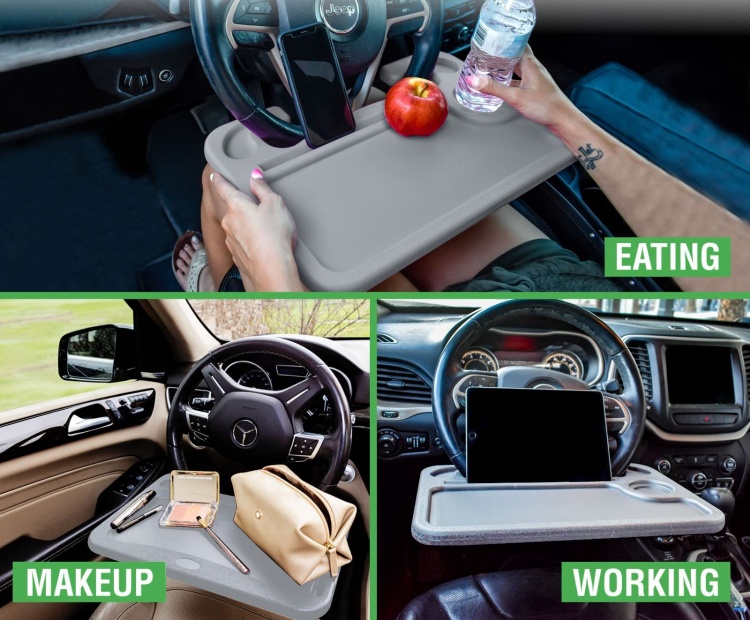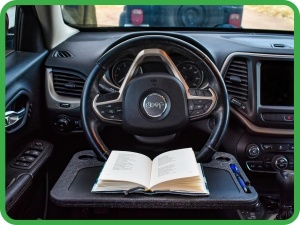
Steering Wheel Desk Accessories You Didn’t Know You Needed
If you spend a lot of time driving for work or even just long commutes, having a portable desk set up in your car can

Steering wheel desks provide an ingenious way to transform idle driving time into productive mobile office work sessions. Attaching directly to your steering wheel, these portable desks offer road warriors and busy professionals a handy workspace for catching up on tasks while in transit.
However, without taking proper precautions, attempting to work from a steering wheel desk while actively driving poses serious safety risks. By following essential usage guidelines, you can optimize your on-the-go productivity while avoiding digital distractions that compromise safe vehicle operation.

Selecting an optimal steering wheel desk maximizes usable workspace while providing essential driving safety:
Size to fit your needs: Consider what devices and items need securing – phones, tablets, mini laptops or large widescreen notebooks? Measure gear dimensions beforehand to ensure the desktop offers adequate surface space without dangerously stacking items.
Sturdy & secure mounting: A weak base risks the entire desk suddenly detaching at high speeds. Prioritize heavy-duty clamps or vice grips during selection to ensure robust vehicle attachment keeping your gear secured in place. Avoid units with flimsy suction cups.
Adjustability features: Look for wide-ranging height, angle and depth adjustability via multi-jointed swing arms and pivoting mounts. This flexibility allows tweaking equipment alignment to avoid airbag obstruction zones while positioning screens ergonomically for your unique posture needs.
Integrated safety restraints: Locking straps, raised edges and textured non-slip pads prevent laptops and delicate gear from crashing around over bumps or erratic maneuvers. Suspended drop stops are essential for anchoring phones securely, preventing smashings if accidentally knocked off desks when packing up.
When putting your new steering wheel desk to use, adhere to these rules for safely integrating mobile work sessions:
Only use when parked: Actively typing or reading screens while simultaneously driving, even briefly, dangerously diverts attention from the road. Only attempt referencing mounted devices when at complete stops to avoid deadly distractions.
Pull over if needed: If a task demands extended viewing or attention exceeding glances, safely pull off the road into a parking area or rest stop. Maximizing work productivity never warrants compromising safe vehicular operation or public roadway safety.
Avoid obstructing airbags: Ensure mounted desks sit entirely outside of airbag deployment zones. Consult owner’s manuals to identify safe positioning regions to avoid obstruction. Failure to align equipment appropriately risks forceful projectile collisions with occupants during airbag inflation events.
Properly stow when not in use: Before pulling away, take a moment to secure the desktop surface and collapsing extremity arms neatly out of the way. This prevents hazardous loose protruding elements from swiveling freely within cabins while driving. Utilize locking straps to firmly contain phones or laptops too.
Maintain proper posture: Hunching over strained downward angles strains necks and backs. Use adjustable mounts to angle screens directly ahead with your head upright for comfortable straight-neck viewing orientation.
Open windows periodically for blasts of fresh breezes preventing stale cabin environments from encouraging drowsiness.
Take regular breaks: Even when stationary, prolonged desktop usage induces fatigue. For every 45 minutes working off the mobile desk, take a 15-minute eyes-off-screen break to stand, stretch and visually rest.
Extend pause durations before complex driving to ensure maximum mental acuity without lingering technological distractions.
Beyond fundamentally safe vehicular operation, additional methods further enhance productivity when leveraging steering wheel desk implementations:
While virtually any car interior feasibly supports electronic mounting, certain models cater better towards dedicated mobile workspace conversion considering inherent chassis design elements:
While quality steering wheel desks form the central hub securing mobile gear, additional affordable gadgets further maximize overall integration functionality:

Long highway hauls pose unique challenges amplified without customary office conveniences or amenity access:
With vast connectivity capabilities minimizing hardware access barriers, modern technology uniquely amplifies remote office functionality:
While beneficial, increased reliance on consistent internet connectivity also warrants heightened cybersecurity mindfulness:
While most steering wheel desks conveniently clip on only when required daily, power users choosing to permanently integrate desks can further enhance implementations:
Hardwire power accessories:
— Professionally routing and wiring charging cables, modems and cellular data hotspots into vehicle electrical systems keeps critical electronic components perpetually powered without cluttering cabins with loose messy wires prone to disconnecting randomly.
Mount auxiliary displays ergonomically:
— Augment limited desktop space by screw mounting ultra slim monitors and adjustable tablet stands onto custom fabricated floor pedestals meeting optimal sight lines. Using articulating mounts, position secondary displays directly ahead, centered symmetrically for comfortable straight neck viewing angles.
Install high-capacity auxiliary batteries:
— Supplement standard engine-charged starter batteries with deep cycle marine and RV batteries independently powering amplification systems without risking the ability to start vehicles remotely. Maintain perpetual readiness by recharging reserves utilizing solar panels.
Fabricate concealed storage solutions:
— Leverage the ample unused space existing behind interior body panels and underneath factory floorboards. Custom-made retracting drawers weld mounted into spare chassis cavities provide securely lockable capacity sheltering valuables entirely shielded out of sight.
Keep fresh air flowing:
— Stale air exacerbates drowsiness, severely compromising alertness. Prevent closed-in feelings by integrating electric cooling fans supplemented by power windows circulating exterior breezes. Openable moon roofs ventilate vehicles naturally.

When leveraging steering wheel-mounted desks for transitory productivity pursuits, remain vigilant in upholding essential safeguards:
By upholding prudent practices plus deploying protective accessories, productivity seekers can responsibly enjoy office-grade efficiency no matter the adventures ahead!


If you spend a lot of time driving for work or even just long commutes, having a portable desk set up in your car can

Steering wheel desks provide a convenient surface for working while commuting or waiting in your vehicle. However, without proper adjustment and good posture habits, you

For road warriors and mobile professionals constantly on the go, transforming driving time into productive work time can be a game-changer for maximizing efficiency. Steering

For many professionals, the vehicle serves merely as transportation between point A and point B. Yet your daily drive likely involves hours per week simply

If you spend a lot of time driving for work or even just long commutes, having a portable desk set up in your car can

Steering wheel desks provide a convenient surface for working while commuting or waiting in your vehicle. However, without proper adjustment and good posture habits, you

Steering wheel desks provide an ingenious way to transform idle driving time into productive mobile office work sessions. Attaching directly to your steering wheel, these

For road warriors and mobile professionals constantly on the go, transforming driving time into productive work time can be a game-changer for maximizing efficiency. Steering
Copyright © 2024 dashdesksteeringwheeldesk. All Rights Reserved.